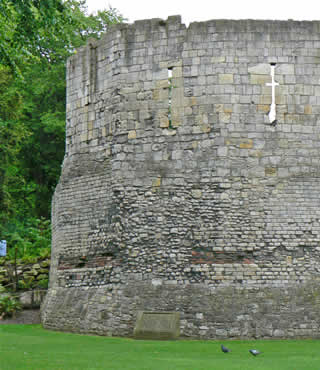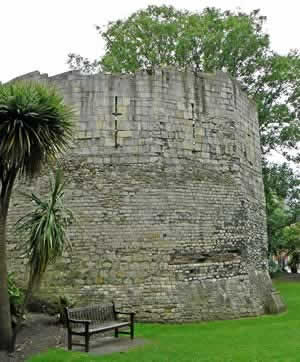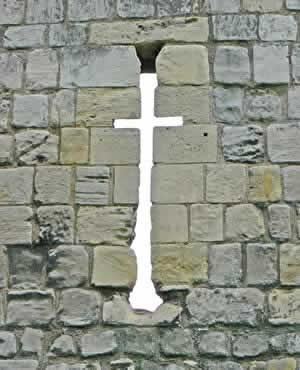Multangular Tower |
|
 |
|||
Almost all that is left of the ancient Roman wall built to protect Eboracum in AD 300 |
|||||
Listen to this article |
|||||
|
|||||
There are dozens of old buildings and structures in York, but there are only a few places left where you can see work dating back to Roman times. The best-known of these are probably the defensive fortifications in Yorkshire Museum's gardens - and in particular, the tower built into these walls. |
|||||
 |
|||||
The first defences ever built on the site were constructed in around 70AD - while some of Jesus' disciples were still alive! However, these were very basic, consisting mainly of turf and clay ramparts, and so the Roman soon upgraded them to wooden battlements, and then to the stone walls still visible today. |
|||||
 Multangular Tower, set amongst the Yorkshire Museum Gardens |
|||||
The tower itself is thought to have been built in either the third or fourth century, although no-one can be exactly sure. Back then, it was known as Elrondyng, but this has since been abandoned in favour of the name Multangular Tower, because of its unusual design. At first glance, it might seem circular, but the tower actually has ten different sides. It stands 19 feet high, and was originally constructed with three floors - so it was big enough to house a catapult. |
|||||
While many towers and forts were built to sit behind the defensive walls, the Multangular Tower was built in front, sticking out from its walls. This was so the defensive soldiers could fire directly down upon their enemies. Despite this, because of its location in the Roman stronghold of Eboracum - as York used to be known - its designers probably never expected the tower to be attacked! |
|||||
This turned out to be wrong, as the tower was involved in many different conflicts for years to come. You can see evidence of this by looking at the wall just along from the main fort - you can still see a hole, caused by an enemy cannonball in the English Civil War! |
|||||
 Inside Multangular Tower |
|||||
By that time, the walls and tower had been vastly improved by medieval architects. Careful observers can still tell the different stages of construction apart - the Roman bricks have medium-sized limestone blocks with a red line running through them - while the later medieval bricks are much larger. The cross-shaped arrow slits near the top of the structure were also built in this later period. Only six metres of the remaining stonework is Roman. |
|||||
While the views of the Multangular Tower are the most impressive from within the Museum Gardens, approaching from the other side allows you to see the fort from the inside. There are five Roman coffins here, which were taken from other graveyards around the city. |
|||||
It may be hard to imagine the tower as the impregnable fortress it once was, but for anyone with the smallest interest in architecture, it's a must see. It's not often that you get to see buildings that are coming to their 2000th birthday. |
|||||
|
|||||
Multangular Tower is open daily 8am to 8pm (8am - 5.30pm in winter). Entry is FREE. |
|||||
|
Pocket Britain is optimised for use on a smartphone or tablet with internet access. All content is subject to copyright. All reasonable methods have been used to ensure information supplied is accurate at the time of publication. However, it is advisable to check information before relying on it. Privacy Policy |